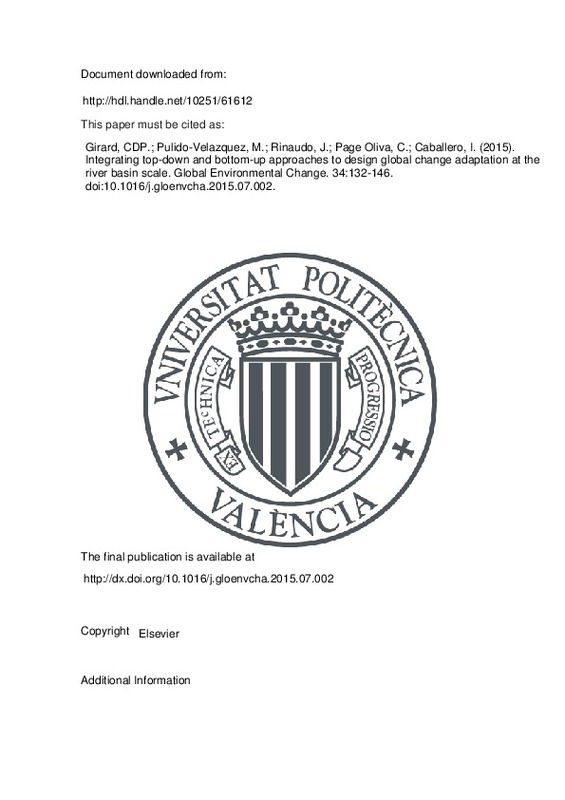JavaScript is disabled for your browser. Some features of this site may not work without it.
Buscar en RiuNet
Listar
Mi cuenta
Estadísticas
Ayuda RiuNet
Admin. UPV
Integrating top-down and bottom-up approaches to design global change adaptation at the river basin scale
Mostrar el registro sencillo del ítem
Ficheros en el ítem
| dc.contributor.author | Girard, Corentin Denis Pierre
|
es_ES |
| dc.contributor.author | Pulido-Velazquez, M.
|
es_ES |
| dc.contributor.author | Rinaudo, Jean-Daniel
|
es_ES |
| dc.contributor.author | Page Oliva, Christian
|
es_ES |
| dc.contributor.author | Caballero, Ivan
|
es_ES |
| dc.date.accessioned | 2016-03-09T13:07:53Z | |
| dc.date.available | 2016-03-09T13:07:53Z | |
| dc.date.issued | 2015-09 | |
| dc.identifier.issn | 0959-3780 | |
| dc.identifier.uri | http://hdl.handle.net/10251/61612 | |
| dc.description.abstract | The high uncertainty associated with the effect of global change on water resource systems calls for a better combination of conventional top-down and bottom-up approaches, in order to design robust adaptation plans at the local scale. The methodological framework presented in this article introduces bottom-up meets top-down integrated approach to support the selection of adaptation measures at the river basin level by comprehensively integrating the goals of economic efficiency, social acceptability, environmental sustainability and adaptation robustness. The top-down approach relies on the use of a chain of models to assess the impact of global change on water resources and its adaptive management over a range of climate projections. Future demand scenarios and locally prioritised adaptation measures are identified following a bottom-up approach through a participatory process with the relevant stakeholders and experts. The optimal combinations of adaptation measures are then selected using a hydro-economic model at basin scale for each climate projection. The resulting adaptation portfolios are, finally, climate checked to define a robust least-regret programme of measures based on trade-offs between adaptation costs and the reliability of supply for agricultural demands. This innovative approach has been applied to a Mediterranean basin, the Orb river basin (France). Mid-term climate projections, downscaled from 9 General Climate Models, are used to assess the uncertainty associated with climate projections. Demand evolution scenarios are developed to project agricultural and urban water demands on the 2030 time horizon. The results derived from the integration of the bottom-up and top-down approaches illustrate the sensitivity of the adaptation strategies to the climate projections, and provide an assessment of the trade-offs between the performance of the water resource system and the cost of the adaptation plan to inform local decision-making. The article contributes new methodological elements for the development of an integrated framework for decision-making under climate change uncertainty, advocating an interdisciplinary approach that bridges the gap between bottom-up and top-down approaches. | es_ES |
| dc.description.sponsorship | The study has been financially supported by BRGM-ONEMA joint project on Hydro-economic modelling and by the IMPADAPT project (CGL2013-48424-C2-1-R) from the Spanish ministry MINECO (Ministerio de Economia y Competitividad) with European FEDER funds. Corentin Girard is supported by a grant from the University Lecturer Training Program (FPU12/03803) of the Ministry of Education, Culture and Sports of Spain. We also acknowledge the CERFACS for the climate scenarios provided from the SCRATCH 2010 dataset (March 2012 release - http://www.cerfacs.fr/similar to page/work/scratch/). We thank as well the anonymous reviewers and the Editors of Global Environmental Change, for their useful and encouraging comments during the review process. | en_EN |
| dc.language | Inglés | es_ES |
| dc.publisher | Elsevier | es_ES |
| dc.relation.ispartof | Global Environmental Change | es_ES |
| dc.rights | Reserva de todos los derechos | es_ES |
| dc.subject | Climate change | es_ES |
| dc.subject | Adaptation measures | es_ES |
| dc.subject | River basin model | es_ES |
| dc.subject | Climate check | es_ES |
| dc.subject | Top down | es_ES |
| dc.subject | Bottom up | es_ES |
| dc.subject.classification | INGENIERIA HIDRAULICA | es_ES |
| dc.title | Integrating top-down and bottom-up approaches to design global change adaptation at the river basin scale | es_ES |
| dc.type | Artículo | es_ES |
| dc.identifier.doi | 10.1016/j.gloenvcha.2015.07.002 | |
| dc.relation.projectID | info:eu-repo/grantAgreement/MINECO//CGL2013-48424-C2-1-R/ES/ADAPTACION AL CAMBIO GLOBAL EN SISTEMAS DE RECURSOS HIDRICOS/ | es_ES |
| dc.relation.projectID | info:eu-repo/grantAgreement/MECD//FPU12%2F03803/ES/FPU12%2F03803/ | es_ES |
| dc.rights.accessRights | Abierto | es_ES |
| dc.contributor.affiliation | Universitat Politècnica de València. Instituto Universitario de Ingeniería del Agua y del Medio Ambiente - Institut Universitari d'Enginyeria de l'Aigua i Medi Ambient | es_ES |
| dc.contributor.affiliation | Universitat Politècnica de València. Departamento de Ingeniería Hidráulica y Medio Ambiente - Departament d'Enginyeria Hidràulica i Medi Ambient | es_ES |
| dc.description.bibliographicCitation | Girard, CDP.; Pulido-Velazquez, M.; Rinaudo, J.; Page Oliva, C.; Caballero, I. (2015). Integrating top-down and bottom-up approaches to design global change adaptation at the river basin scale. Global Environmental Change. 34:132-146. https://doi.org/10.1016/j.gloenvcha.2015.07.002 | es_ES |
| dc.description.accrualMethod | S | es_ES |
| dc.relation.publisherversion | http://dx.doi.org/10.1016/j.gloenvcha.2015.07.002 | es_ES |
| dc.description.upvformatpinicio | 132 | es_ES |
| dc.description.upvformatpfin | 146 | es_ES |
| dc.type.version | info:eu-repo/semantics/publishedVersion | es_ES |
| dc.description.volume | 34 | es_ES |
| dc.relation.senia | 292666 | es_ES |
| dc.contributor.funder | Ministerio de Economía y Competitividad | es_ES |
| dc.contributor.funder | Bureau de Recherches Géologiques et Minières | es_ES |
| dc.contributor.funder | Ministerio de Educación, Cultura y Deporte | es_ES |
| dc.contributor.funder | European Regional Development Fund | es_ES |







![[Cerrado]](/themes/UPV/images/candado.png)

